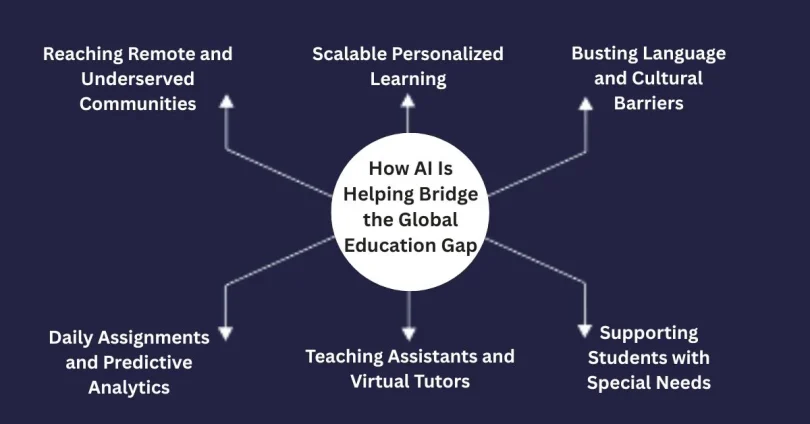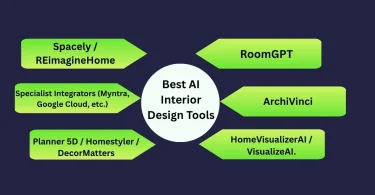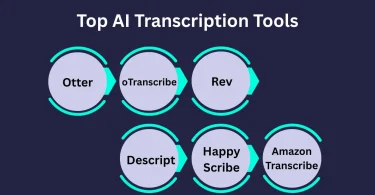Many children in developing countries have been unable to access quality education over the years. Students in more affluent nations may have access to well-funded schools and trained teachers, while students in low-income areas have to deal with limited resources, overcrowded classrooms, and a serious shortage of trained teachers. This persistent educational disparity intensifies poverty and restricts the possibility of social mobility.
Think about a world where every child, no matter their zip code or upbringing, has the chance to get a quality education. Sounds far-fetched? Maybe not. As Artificial Intelligence in education becomes more common, that dream is becoming more of a reality, even in the most resource-scarce regions.
It is changing the way education is being taught, whether it is through AI-based learning applications or intelligent tutoring systems. It provides new opportunities to assist students, adjust to their unique needs, and open the doors that were closed before. AI is having a revolutionary impact on reducing the education gap in the world by making learning more personal, accessible, and inclusive.
So, what is the role of AI in making the playing field more even and providing students in underserved communities with a chance to succeed? Let us examine it in more detail.
Scalable Personalized Learning
Personalized learning is one of the largest transformations of AI in education. Smart algorithms on platforms such as Khan Academy, Carnegie Learning, Duolingo, and Squirrel AI in China are used to adjust lessons to the pace and strengths of each student. These systems identify when a learner is having trouble and adapt the content to the learner, basically providing each student with a custom learning path. An example is Squirrel AI, which divides complex topics into thousands of tiny learning points, guaranteeing specific assistance. This kind of personalization not only keeps students from falling behind but can boost academic performance by up to 20%.
Reaching Remote and Underserved Communities
The education tools powered by AI are assisting in closing the gap for students in rural and low-resource regions. In India, tools like Shiksha Co-pilot help teachers create better, more effective lesson plans with less hassle. In the meantime, offline learning platforms such as Kolibri and Rumie make offline learning a reality by preloading tablets, ideal in areas with poor or no internet connection. These AI projects help level the playing field, making sure students in rural areas get the same quality education as those in cities.
Busting Language and Cultural Barriers
AI in education addresses the issue of language differences directly. Educational materials can be translated into the native languages of students in real-time with the help of such tools as Google Translate and Microsoft Translator. Platforms even localize content to local cultures, which makes students more engaged and more aware of what they are learning. Such support enables the students to study in their native language and help in bridging the global education gap.
Teaching Assistants and Virtual Tutors
Shortage of trained teachers is a serious issue in developing nations/poor countries. AI comes here to play the role of a virtual tutor. There are apps such as Brainly, Socratic, and Gemini by Google that provide real-time homework and assignment assistance. Khan Academy goes even further with its Khanmigo, which is an AI tutor available 24/7 and allows students to learn and receive assistance at any time. These AI assistants not only respond to questions, but they also relieve teachers and encourage self-education.
Daily Assignments and Predictive Analytics
AI systems can monitor the behavior of students, such as attendance, homework performance, and test scores, to determine which students may be lagging behind. Such insights enable educators or mentors to intervene at an early stage, either through additional tutoring or community outreach. In Nigeria, students who used an AI tutoring system demonstrated two years of conventional learning growth in only six weeks. That’s the power of acting early with the right tools.
Supporting Students with Special Needs
AI is also increasing accessibility to learning among students with disabilities. Tools such as text-to-speech, speech-to-text, visual recognition, and live captions allow students with vision, hearing, or learning impairments to interact with the content more comfortably. Google Lookout and Seeing AI are good examples of such apps; these provide inclusive learning experiences and enable all students to succeed, despite their abilities.
Increasing the Productivity of Teachers
AI is also beneficial to teachers. They will be able to save time and concentrate more on teaching with automated grading, lesson planning and attendance tracking. AI provides useful information regarding student performance, which can be used by educators to adjust their teaching methods. AI serves as a mentor and helps teachers navigate the digital tools and become more effective in the classroom. To a great extent, AI can be compared to an assistant that never sleeps and assists teachers in doing what they are best at doing, which is teaching and inspiring.
Some Real-World Examples of How AI Is Closing the Global Education Gap
MindSpark (India), Personalized Learning for Low-Income Students
MindSpark is an adaptive AI platform used in Indian slums and government schools. It tailors content to student levels, significantly improving math and reading skills in just four months.
Kolibri, Offline AI-Powered Education for Remote Communities
Kolibri delivers AI-assisted digital lessons without the internet. Used in refugee camps and remote schools, it helps teachers guide learners using low-cost hardware.
Squirrel AI (China), Scalable Adaptive Learning
Squirrel AI breaks content into micro-units, providing custom learning paths. Deployed in over 1,700 centers across China, it’s helping close the urban-rural education gap.
Shiksha Copilot (India), AI Assistance for Rural Teachers
Developed by Microsoft, this AI tool supports rural Indian teachers with lesson planning and content creation, improving teaching quality in low-resource classrooms.
Solve Education, Gamified Learning for Out-of-School Youth
This mobile app uses AI and games to teach English, math, and digital skills to underserved youth in Nigeria, India, and Indonesia.
Thinking Huts (Madagascar), 3D-Printed Smart Schools
Thinking Huts builds 3D-printed schools equipped for AI-based learning, offering affordable, fast infrastructure to improve education access in poor communities.
Khanmigo by Khan Academy, Free AI Tutoring for All
Khanmigo is like a personal tutor, guiding students through stuff like coding, homework, and getting ready for college. Freely available, making quality learning support more accessible worldwide.
Conclusion
As we have learned, AI is not a far-fetched dream, but it is already being used to make the educational playing field more even. Whether it is providing customized instruction in remote classrooms or providing virtual tutors that never take a nap, AI technologies are transforming students, educators, and schools in underserved communities. To have a worldwide impact, we must consider implementation, ethical governance, and further investment in infrastructure.
Promote ethical application of AI in your community, assist schools in low-connectivity areas, and focus on AI literacy among students and educators. When we strike the right balance between innovation and humanity, we open up learning to all children, everywhere.
FAQs
AI platforms examine the answers of each student to identify gaps in knowledge and adjust the lessons and feedback to the pace and strengths of the student. This method is most beneficial to struggling students as they can recover at a quicker rate.
Yes, only if we don’t ensure equal access to technology. Schools must close the digital divide, especially in underserved regions, to prevent AI from reinforcing existing gaps.
Education leaders must begin by posing the following question: What issues do we wish AI to address? What are the ethical precautions and teacher preparation? The strategic planning today guarantees the responsible and useful use of AI in education tomorrow.




Leave a Comment